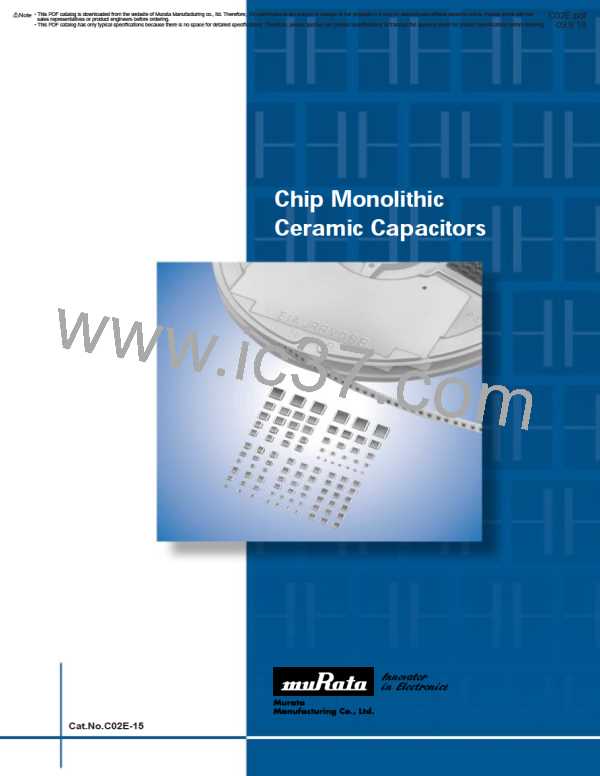• This PDF catalog is downloaded from the website of Murata Manufacturing co., ltd. Therefore, it’s specifications are subject to change or our products in it may be discontinued without advance notice. Please check with our
• Please read rating and !CAUTION (for storage, operating, rating, soldering, mounting and handling) in this catalog to prevent smoking and/or burning, etc.
!Note
!Note
C02E.pdf
sales representatives or product engineers before ordering.
• This catalog has only typical specifications because there is no space for detailed specifications. Therefore, please approve our product specifications or transact the approval sheet for product specifications before ordering0. 9.9.18
• This PDF catalog has only typical specifications because there is no space for detailed specifications. Therefore, please approve our product specifications or transact the approval sheet for product specifications before ordering.
(1)
ERB Series Specifications and Test Methods
Specifications
No.
1
Item
Operating
Test Method
Reference Temperature: 25°C
Y55 to W125D
Temperature Range
The rated voltage is defined as the maximum voltage which
may be applied continuously to the capacitor.
P-P
O-P
2
Rated Voltage
See the previous pages.
When AC voltage is superimposed on DC voltage, V or V ,
whichever is larger, should be maintained within the rated
voltage range.
Visual inspection
Using calipers
3
4
Appearance
Dimensions
No defects or abnormalities
Within the specified dimension
No failure should be observed when 300%(*) of the rated volt-
age is applied between the terminations for 1 to 5 seconds,
provided the charge/discharge current is less than 50mA.
(*) 300V: 250%, 500V: 200%
5
Dielectric Strength No defects or abnormalities
The insulation resistance should be measured with a DC
voltage not exceeding the rated voltage at 25D and standard
humidity and within 2 minutes of charging.
6
1,000,000MΩ min. (CV470pF)
0,100,000MΩ min. (CG470pF)
Insulation Resistance
(I.R.)
6
7
Capacitance
Q
Within the specified tolerance
The capacitance/Q should be measured at 25D at the
frequency and voltage shown in the table.
220pF<CV1,220pF : QU10,000
220pF<CV1,470pF : QU15,000
470pF<CV1,000pF : QU13,000
C: Nominal Capacitance (pF)
Frequency
Voltage
1T0.1MHz
1T0.2Vrms
8
Capacitance
Change
The temperature coefficient is determined using the
Within the specified tolerance (Table A-6)
Within the specified tolerance (Table A-6)
capacitance measured in step 3 as a reference. When cycling
the temperature sequentially from step 1 through 5, the
capacitance should be within the specified tolerance for the
temperature coefficient and capacitance change as Table A.
The capacitance drift is calculated by dividing the differences
between the maximum and minimum measured values in steps
1, 3 and 5 by the capacitance value in step 3.
Temperature
Coefficient
Capacitance
Temperature
Characteristics
9
Step
Temperature (D)
25T2
1
Capacitance Within T0.2% or T0.05pF
Drift
(Whichever is larger)
2
3
4
5
Y55T3
25T2
125T3
25T2
No removal of the terminations or other defects should occur.
Solder the capacitor on the test jig (glass epoxy board) shown
in Fig. 1 using an eutectic solder.
Then apply 10N* force in parallel with the test jig for 10±1sec.
The soldering should be done either with an iron or using the
reflow method and should be conducted with care so that the
soldering is uniform and free of defects such as heat shock.
c
Adhesive Strength
of Termination
10
Type
a
b
c
ERB18
ERB21
ERB32
1.0
1.2
2.2
3.0
4.0
5.0
1.2
1.65
2.9
Solder Resist
Baked Electrode or
Copper Foil
Fig.1
(in mm)
*5N (ERB188)
Continued on the following page.
116

 MURATA [ muRata ]
MURATA [ muRata ]